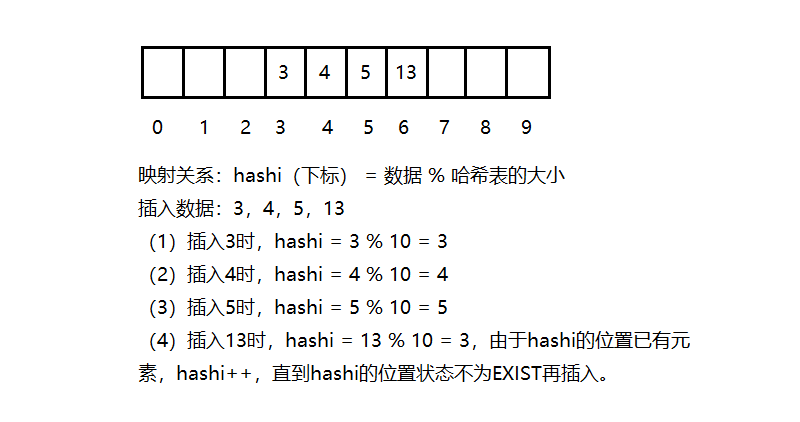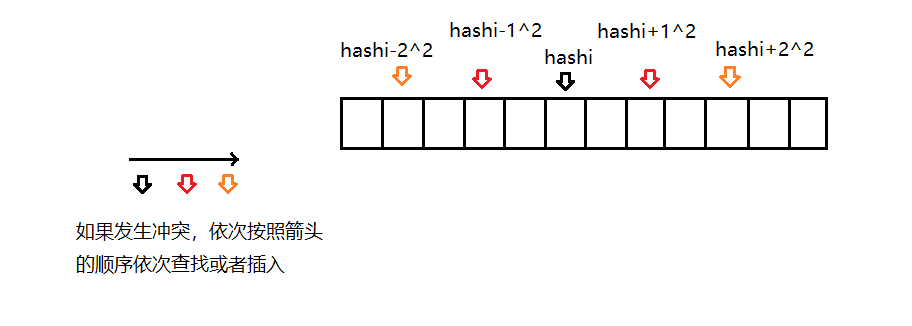哈希表
在C++11中,STL新增了4个unordered_xxx系列的关联式容器,它们在用法上和红黑树的关联式容器类似。但在查询效率上,unordered_xxx系列略胜一筹。红黑树中的节点非常多时,查询效率也不理想(需要进行多次比较),最坏情况下要比较高度次,unordered_xx系列容器进行很少的比较次数就能够将元素找到。
1. unordered_map
1.1 概念
- unordered_map存储的是pair<key,value>的键值对。
- unordered_map的key是唯一的,通过key可以找到对应的value。
- unordered_map存储的元素是无序的。
- unordered_map的迭代器是单向迭代器(前向迭代器)。
- unordered_map支持[]访问,通过key返回value。
1.2 常见接口
- 构造
- 容量
- 迭代器
只有正向迭代器,没有反向迭代器。
- 元素查找
(1)find
(2)count
(3)equal_range
- 插入和删除
- 哈希桶
- []访问
2. unordered_set
2.1 概念
2.1 常见接口
unordered_set的常见接口和unordered_map的接口一样,这里就不赘述。
3. 底层实现
unordered系列的关联式容器之所以效率比较高,是因为其底层使用了哈希结构。
3.1 哈希
- 哈希是存储的值与存储位置建立一个一一映射的关系。哈希表就是用哈希函数建立的结构,通过这层关系就可以找到想要的元素,不需要红黑树需要进行多次比较。
- 不同关键字通过相同哈希哈数计算出相同的哈希地址,该种现象称为哈希冲突或哈希碰撞。这些不同关键字映射出相同的哈希函数,叫做同义词。
- 如何解决哈希冲突?可以根据不同的场景,使用合适的哈希函数。
3.2 哈希函数
这里讲的两种方法是最常见的。
- 直接定址法
取关键字的某个线性函数为散列地址:Hash(Key)= A*Key + B。这种方法比较简单,映射的哈希函数值比较均匀。但是只适用于范围集中的关键字,否则映射的哈希值的差越大,浪费的空间越多。
- 除留余数法
设散列表中允许的地址数为m,取一个不大于m,但最接近或者等于m的质数p作为除数,
按照哈希函数:Hash(key) = key% p(p<=m),将关键码转换成哈希地址。
3.3 闭散列和开散列
闭散列和开散列是解决哈希冲突的方法,采用的哈希函数是除留余数法。
3.3.1 闭散列
闭散列(也叫开放定址法),在插入关键字时,如果关键字映射的哈希地址内容为空,直接填入关键字,如果关键字映射的哈希地址内容非空,将关键字填入下一个空位置。这下一个空位置,可以由两种方法得到:线性探测和二次探测。
- 线性探测
(1)在插入元素发现,映射的位置发生冲突,此时向后探测,直到发现空位置即可。
(2)在删除元素时,不能直接删除,因为删除后会影响元素的查找和插入,应该用标记法记录元素此时的状态。
(3)如果不停地插入元素,最终找不到空位置,怎么办?不会找不到空位置的 ,在哈希表中元素个数和哈希表的长度达到某种关系后,就会扩容。这种关系就是负载因子α = 元素个数/哈希表的长度,α越大,产生冲突的概率越大,α越小,产生冲突的概率越小,但浪费的空间越多。所以选择合适的α是有必要的,一般α的范围是0.7~0.8。也就是说,当α到达这个范围就得扩容。
(4)如果插入元素不是整数,怎么办?想办法把它转换成整数。
//在取模操作时,如果key不是整形,怎么办?想办法让它转换成整形,确保查找和删除时能准确定位,建立新的映射关系。
//为此,可以写个仿函数
template<class K>
struct ConvertToInt
{
size_t operator()(const K& key)
{
return size_t(key);
}
};
//如果key是个string,如何将string转换成整形
//返回第一个字符,那就太容易冲突;将所有字符加起来,但string的字符顺序不同,转换成整形相同,也容易冲突
//可以用到一些大佬的算法:BKDR算法。就可以减少冲突。
template<>
struct ConvertToInt< string >
{
size_t operator()(const string&str)
{
size_t hash = 0;
for (auto e : str)
{
hash *= 131;
hash += e;
}
return hash;
}
};
namespace open_address
{
//元素状态
//为什么要设置元素的状态?当元素被删除,与该元素有相同余数的元素就得往前挪一位,效率低
//所以设置状态标记,将删除元素的位置设置为DELETE,有元素的位置设置为EXIST,没有元素的位置设置为EMPTY
enum state
{
EXIST,
EMPTY,
DELETE
};
//哈希表存储元素的类型
//假设存储的是pair
template<class K,class V>
struct HashData
{
pair<K, V> _data;
state _state = EMPTY;
};
template<class K,class V,class HashFunc = ConvertToInt<K>>
class HashTable
{
public:
HashTable()
{
//初始大小设置为10
_table.resize(10);
}
//查找
HashData<const K, V>* Find(const K&key)
{
HashFunc hf;
//除留余数法,获得在哈希表中的下标。
//为什么不%_capacity?如果%capacity,下标可能大于size,但[]访问限制下标<size。
int hashi = hf(key) % _table.size();
//为什么查找到状态为EMPTY的元素就结束?因为哈希表是不会满的,否则效率就降低。
while (_table[hashi]._state != EMPTY)
{
if(_table[hashi]._state == EXIST && _table[hashi]._data.first == key)
{
return (HashData<const K, V>*) & _table[hashi];
}
++hashi;
//防止越界
hashi %= _table.size();
}
return nullptr;
}
//插入
bool Insert(const pair<K, V>& data)
{
if (Find(data.first))
{
return false;
}
//考虑扩容
//负载因子 = 填入表中的元素个数(_n)/散列表的长度(_table.size())
//负载因子越大,发生冲突的概率越大;负载因子越小,发生冲突的概率越小,空间利用率越低。
//哈希表不能满了再扩容,控制负载因子到一定值就扩容,比如0.7
if ((double)_n / _table.size() >= 0.7)
{
//扩容后有些值的映射关系可能发生变化。原本冲突的现在不一定冲突;原本不冲突的现在可能冲突
HashTable<K, V> newHT;
newHT._table.resize(_table.size() * 2);
for (auto& e : _table)
{
if (e._state == EXIST)
{
//newHT空间足够,就不会进到扩容里面,不会造成死循环
newHT.Insert(e._data);
}
}
_table.swap(newHT._table);
}
HashFunc hf;
int hashi = hf(data.first) % _table.size();
//不用担心找不到状态为空的位置,因为前面已经扩容
while (_table[hashi]._state == EXIST)
{
++hashi;
hashi %= _table.size();
}
_table[hashi]._data = data;
_table[hashi]._state = EXIST;
++_n;
return true;
}
//删除
bool Erase(const K& key)
{
HashData<const K,V>*ret = Find(key);
if (ret)
{
//不能直接删除,应该将状态置成DELETE
ret->_state = DELETE;
--_n;
return true;
}
return false;
}
private:
vector<HashData<K, V>> _table;
size_t _n = 0;//哈希表中有效元素(不包括删除的节点)的个数
};
}
- 二次探测
二次探测是在存储位置冲突时,在hashi+i ^2的位置或者在hashi-i ^2的位置,i取决于在查找和插入时冲突的次数。二次探测只是存储位置的规则发生变化,其他与线性探测一样。
3.3.2 开散列
闭散列的方法空间利用率太低,浪费空间,且冲突会相互影响,你抢占我的位置,我抢占他的位置。所以就有第二种方法开散列(也叫拉链法/哈希桶)。
开散列的实现
//解决哈希冲突的方法:拉链法/哈希桶
//在取模操作时,如果key不是整形,怎么办?想办法让它转换成整形,确保查找和删除时能准确定位,建立新的映射关系。
//为此,可以写个仿函数
template<class K>
struct ConvertToInt
{
size_t operator()(const K& key)
{
return size_t(key);
}
};
//如果key是个string,如何将string转换成整形
//返回第一个字符,那就太容易冲突;将所有字符加起来,但string的字符顺序不同,转换成整形相同,也容易冲突
//可以用到一些大佬的算法:BKDR算法。
template<>
struct ConvertToInt< string >
{
size_t operator()(const string&str)
{
size_t hash = 0;
for (auto e : str)
{
hash *= 131;
hash += e;
}
return hash;
}
};
namespace hash_bucket
{
//节点
//不同于开放定址法,哈希桶放的是节点
template<class K, class V>
struct HashNode
{
pair<K, V> _data;
HashNode<K, V>* _next;
HashNode(const pair<K, V>& data)
:_data(data)
, _next(nullptr)
{}
};
//哈希表
template<class K, class V, class HashFunc = ConvertToInt<K>>
class HashTable
{
public:
typedef HashNode<K, V> Node;
//构造
HashTable()
{
//先开10个哈希桶
_table.resize(10,nullptr);
}
//析构
//析构函数需要自己定义,因为指针是内置类型,编译器不会调用其析构
~HashTable()
{
for (size_t i = 0; i < _table.size(); i++)
{
Node* cur = _table[i];
Node* next = nullptr;
while (cur)
{
next = cur->_next;
delete cur;
cur = next;
}
_table[i] = nullptr;
}
}
//查找
Node* Find(const K& key)
{
HashFunc hf;
size_t hashi = hf(key) % _table.size();
Node* cur = _table[hashi];
while (cur)
{
if (cur->_data.first == key)
{
return cur;
}
cur = cur->_next;
}
return nullptr;
}
//插入
bool Insert(const pair<K,V>& data)
{
if (Find(data.first))
{
return false;
}
HashFunc hf;
//扩容
//为什么还需要扩容?将元素挂在哈希桶不就可以了,不用考虑容量问题。
//不扩容,不断插入节点,某些桶越来越长,和链表一样,查找效率就下降了。
//负载因子可以适当放大,一般负载因子控制在1,平均下来每个桶一个元素,这样查找效率就很高。
if (_n == _table.size())
{
vector<Node*> newtable;
size_t newsize = _table.size() * 2;
newtable.resize(newsize, nullptr);
//遍历旧表,将旧表中的节点牵过来,挂在新表对应的位置
for (size_t i = 0; i < _table.size(); i++)
{
Node* cur = _table[i];
while (cur)
{
Node* next = cur->_next;
//在新表中,插入位置可能改变
size_t hashi = hf(cur->_data.first) % newsize;
//头插
cur->_next = newtable[hashi];
newtable[hashi] = cur;
cur = next;
}
_table[i] = nullptr;
}
_table.swap(newtable);
}
size_t hashi = hf(data.first) % _table.size();
//头插
Node* newnode = new Node(data);
newnode->_next = _table[hashi];
_table[hashi] = newnode;
++_n;
return true;
}
//删除
bool Erase(const K& key)
{
HashFunc hf;
size_t hashi = hf(key) % _table.size();
Node* cur = _table[hashi];
Node* prev = nullptr;
while (cur)
{
if (cur->_data.first == key)
{
if (prev)
{
prev->_next = cur->_next;
}
else
{
_table[hashi] = cur->_next;
}
delete cur;
return true;
}
prev = cur;
cur = cur->_next;
}
return false;
}
//打印
void Print()
{
for (size_t i = 0; i < _table.size(); i++)
{
printf("[%d]->", i);
Node* cur = _table[i];
while (cur)
{
cout << cur->_data.first << ":" << cur->_data.second << "->";
cur = cur->_next;
}
cout << "NULL" << endl;
}
cout << endl;
}
private:
vector<Node*> _table;
size_t _n;
};
}
3.4 模拟实现
3.4.1 改造哈希桶
template<class K>
struct ConvertToInt
{
size_t operator()(const K& key)
{
return (size_t)key;
}
};
template<>
struct ConvertToInt< string >
{
size_t operator()(const string&str)
{
size_t hash = 0;
for (auto e : str)
{
hash *= 131;
hash += e;
}
return hash;
}
};
//改造哈希桶,将它封装成unordered_set和unordered_map
namespace hash_bucket
{
//节点
//不同于开放定址法,哈希桶放的是节点
template<class T>
struct HashNode
{
T _data;
HashNode<T>* _next;
HashNode(const T& data)
:_data(data)
, _next(nullptr)
{}
};
//前置声明
//哈希表定义在后,在迭代器使用哈希表指针,得前置声明
//K是关键码的类型;T是存储元素的类型,如果是unordered_set,T就是K,如果是unordereed_map,T就是键值对;
//KeyOfT是仿函数,可以提取T中的K;HashFunc是仿函数,可以将K转换成整形
template<class K, class T, class KeyOfT, class HashFunc>
class HashTable;
//迭代器
//为了实现简单,在哈希桶的迭代器类中需要用到HashTable本身
template<class K, class T, class Ref, class Ptr, class KeyOfT, class HashFunc>
struct HashTableIterator
{
typedef HashNode<T> Node;
typedef HashTableIterator<K, T, Ref, Ptr, KeyOfT, HashFunc> Self;
typedef HashTableIterator<K, T, T&, T*, KeyOfT, HashFunc> iterator;
//当是const_iterator的构造,支持iterator转换成const_iterator
//当是普通迭代器,这个函数是拷贝构造
HashTableIterator(const iterator& it)
:_node(it._node)
, _pht(it._pht)
{}
Node* _node;
//在迭代器中没有修改_pht的需要,所以可以是const类型
const HashTable<K, T, KeyOfT, HashFunc>* _pht;//指向哈希表的指针
HashTableIterator(Node* node,HashTable<K,T,KeyOfT,HashFunc>* pht)
:_node(node)
,_pht(pht)
{}
//重载一个构造,用来接受const修饰的HashTable
HashTableIterator(Node* node, const HashTable<K, T, KeyOfT, HashFunc>* pht)
:_node(node)
, _pht(pht)//_pht也必须是const类型,否则权限就放大
{}
Ref operator*()
{
return _node->_data;
}
Ptr operator->()
{
return &(_node->_data);
}
Self& operator++()
{
//当前桶还没完
if (_node->_next)
{
_node = _node->_next;
}
//当前桶已走到头,通过哈希表指针走到下一个桶
else
{
KeyOfT kot;
HashFunc hf;
size_t hashi = hf(kot(_node->_data)) % _pht->_table.size();
//从下一个位置开始查找一个不为空的桶
++hashi;
while (hashi < _pht->_table.size())
{
if (_pht->_table[hashi])
{
_node = _pht->_table[hashi];
return *this;
}
++hashi;
}
_node = nullptr;
}
return *this;
}
bool operator!=(const Self& s)
{
return _node != s._node;
}
bool operator==(const Self& s)
{
return _node == s._node;
}
};
//哈希表
template<class K, class T, class KeyOfT, class HashFunc = ConvertToInt<K>>
class HashTable
{
public:
typedef HashNode<T> Node;
typedef HashTableIterator<K, T, T&, T*, KeyOfT, HashFunc> iterator;
typedef HashTableIterator<K, T, const T&, const T*, KeyOfT, HashFunc> const_iterator;
// 友元声明
template<class K, class T, class Ref, class Ptr, class KeyOfT, class HashFunc>
friend struct HashTableIterator;
iterator begin()
{
for (size_t i = 0; i < _table.size(); i++)
{
if (_table[i])
{
return iterator(_table[i], this);
}
}
return iterator(nullptr, this);
}
iterator end()
{
return iterator(nullptr, this);
}
const_iterator begin()const
{
for (size_t i = 0; i < _table.size(); i++)
{
if (_table[i])
{
//const修饰的this指向的内容,传this过去
//构造必须要必须用const修饰的HashTable接收
return const_iterator(_table[i], this);
}
}
return const_iterator(nullptr, this);
}
const_iterator end()const
{
return const_iterator(nullptr, this);
}
//构造
HashTable()
{
//先开10个哈希桶
_table.resize(10,nullptr);
}
//析构
//析构函数需要自己定义,因为指针是内置类型,编译器不会调用其析构
~HashTable()
{
for (size_t i = 0; i < _table.size(); i++)
{
Node* cur = _table[i];
Node* next = nullptr;
while (cur)
{
next = cur->_next;
delete cur;
cur = next;
}
_table[i] = nullptr;
}
}
//查找
iterator Find(const K& key)
{
KeyOfT kot;
HashFunc hf;
size_t hashi = hf(key) % _table.size();
Node* cur = _table[hashi];
while (cur)
{
if (kot(cur->_data) == key)
{
return iterator(cur, this);
}
cur = cur->_next;
}
return iterator(nullptr, this);
}
//插入
pair<iterator,bool> Insert(const T& data)
{
KeyOfT kot;
iterator it = Find(kot(data));
if (it!=end())
{
return make_pair(it,false);
}
HashFunc hf;
//扩容
//为什么还需要扩容?将元素挂在哈希桶不就可以了,不用考虑容量问题。
//不扩容,不断插入节点,某些桶越来越长,和链表一样,查找效率就下降了。
//负载因子可以适当放大,一般负载因子控制在1,平均下来每个桶一个元素,这样查找效率就很高。
if (_n == _table.size())
{
vector<Node*> newtable;
size_t newsize = _table.size() * 2;
newtable.resize(newsize, nullptr);
//遍历旧表,将旧表中的节点牵过来,挂在新表对应的位置
for (size_t i = 0; i < _table.size(); i++)
{
Node* cur = _table[i];
while (cur)
{
Node* next = cur->_next;
//在新表中,插入位置可能改变
size_t hashi = hf(kot(cur->_data)) % newsize;
cur->_next = newtable[hashi];
newtable[hashi] = cur;
cur = next;
}
_table[i] = nullptr;
}
_table.swap(newtable);
}
size_t hashi = hf(kot(data)) % _table.size();
//头插
Node* newnode = new Node(data);
newnode->_next = _table[hashi];
_table[hashi] = newnode;
++_n;
return make_pair(iterator(newnode, this), true);
}
//删除
bool Erase(const K& key)
{
KeyOfT kot;
HashFunc hf;
size_t hashi = hf(key) % _table.size();
Node* cur = _table[hashi];
Node* prev = nullptr;
while (cur)
{
if (kot(cur->_data) == key)
{
if (prev)
{
prev->_next = cur->_next;
}
else
{
_table[hashi] = cur->_next;
}
delete cur;
return true;
}
prev = cur;
cur = cur->_next;
}
return false;
}
//打印
void Print()
{
KeyOfT kot;
for (size_t i = 0; i < _table.size(); i++)
{
printf("[%d]->", i);
Node* cur = _table[i];
while (cur)
{
cout << cur->_data.first << ":" << cur->_data.second << "->";
cur = cur->_next;
}
cout << "NULL" << endl;
}
cout << endl;
}
private:
vector<Node*> _table;
size_t _n;
};
}
3.4.2 模拟实现unordered_set
#include"MyHashTable.h"
namespace zn
{
template<class K>
class unordered_set
{
struct SetKeyOfT
{
const K& operator()(const K& key)
{
return key;
}
};
public:
//unordered_set的key不能修改,所以普通迭代器的底层是const迭代器
//+typename告诉编译器,这是内置类型,不是静态成员
typedef typename hash_bucket::HashTable<K, K, SetKeyOfT>::const_iterator iterator;
typedef typename hash_bucket::HashTable<K, K, SetKeyOfT>::const_iterator const_iterator;
//调用const迭代器,得用const修饰的this调用
iterator begin()const
{
return _ht.begin();
}
iterator end()const
{
return _ht.end();
}
//unordered_set的insert返回值中的iterator实际上是const_iterator
pair<iterator,bool> insert(const K& key)
{
//HashTable的insert返回值中的iterator是普通迭代器
//我们期望iterator转换成const_iterator,就得写一个const_iterator的构造
pair<typename hash_bucket::HashTable<K, K, SetKeyOfT>::iterator, bool>ret = _ht.Insert(key);
return pair<iterator, bool>(ret.first, ret.second);//将ret.first赋值给const_iterator,会调用const_iterator的构造
}
private:
hash_bucket::HashTable<K, K, SetKeyOfT> _ht;
};
}
3.4.3 模拟实现unordered_map
#include"MyHashTable.h"
namespace zn
{
template<class K, class V>
class unordered_map
{
struct MapKeyOfT
{
const K& operator()(const pair<const K,V>& kv)
{
return kv.first;
}
};
public:
typedef typename hash_bucket::HashTable<K, pair<const K,V>, MapKeyOfT>::iterator iterator;
typedef typename hash_bucket::HashTable<K, pair<const K, V>, MapKeyOfT>::const_iterator const_iterator;
iterator begin()
{
return _ht.begin();
}
iterator end()
{
return _ht.end();
}
const_iterator begin()const
{
return _ht.begin();
}
const_iterator end()const
{
return _ht.end();
}
pair<iterator,bool> insert(pair<const K,V>& kv)
{
return _ht.Insert(kv);
}
V&operator[](const K& key)
{
pair<iterator, bool> ret = insert(make_pair(key, V()));
return ret.first.second;
}
private:
hash_bucket::HashTable<K, pair<const K,V>, MapKeyOfT> _ht;
};
}














